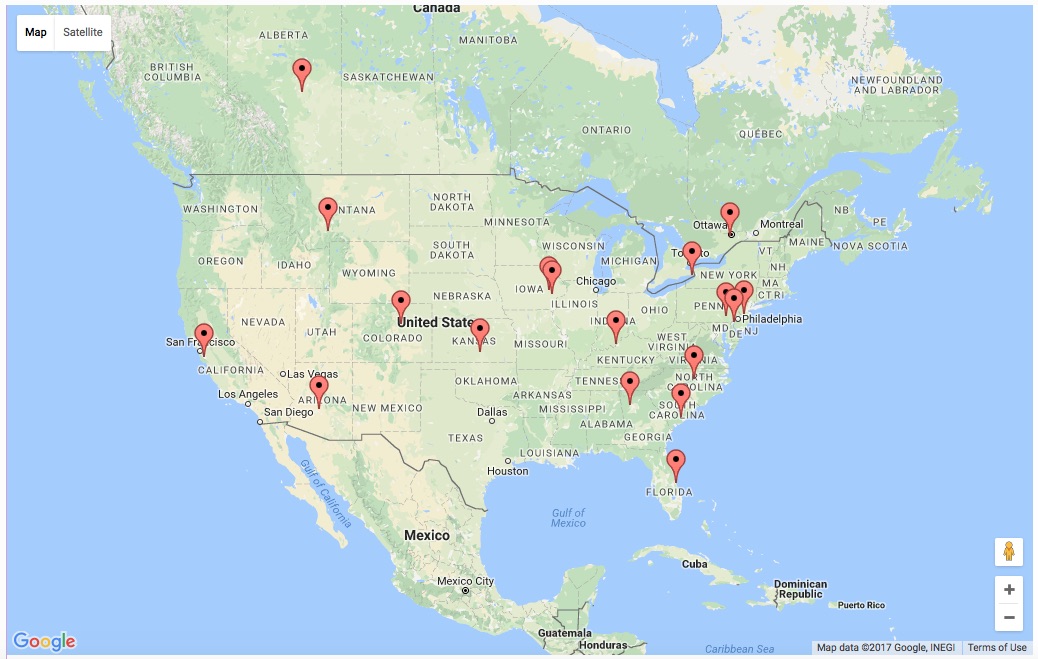Introduction
The 2016 election offers some very valuable lessons for anyone involved in social activism or politics. We saw many good examples of what failed as well as what actually worked to bring about change and energize public interest.
For those who lost, the following is sort of a mirror opposite of what failed to produce success. It’s what we could of done, and still can do, to bring about positive change.
Although written for progressives, the principles and strategies outlined here would work for just about any group, conservative or liberal, wanting to bring about public support for their cause.
Progressive Values and Goals
I’ve been a lifelong progressive. To me, being a progressive means:
- Promoting diplomacy and resisting war (hot or cold wars).
- Promoting sustainability and discouraging environmental destruction.
- Working for people to have safe working conditions and a fair livable wage.
- Creating a society that’s welcoming and supportive of minorities and others who might otherwise be targets of bullying or unfair treatment.
- Working for a fair, effective, and transformative justice system.
- Working toward greater funding for public education.
- Working for a more equitable, democratic, and inclusive world.
- Working against taxpayer money being used to fund the wealthy.
- Working for equal access to opportunity, which means equal access to education, jobs, and financial resources.
These aren’t necessarily partisan values or positions. There are examples of people from all political and social backgrounds advancing these causes. However, without a comprehensive progressive movement, I’m concerned these values are at risk of extinction. So, I’m concerned about anything that might erode the growth and effectiveness of a progressive movement.
Here’s a list of eleven action points for moving forward.
1 – Align With Principles Not Parties
Rather than aligning with a particular party, and working to defend everything that party does, it’s better to identify your own goals, values, principles, issues, and positions. Party loyalty should not eclipse your own values and principles. Make an effort to connect with people from any party as well as independents. Because of the popularity of ‘non-partisan’ causes and claims, there have been occasions when an organization is marketed as being ‘independent’ when everyone knows it’s a front organization for one party or another. Such efforts just come across as insincere, calculated, and manipulative. If a cause-based group claims to be independent, then it shouldn’t be a recruiting arm for a particular party. It should genuinely be non-partisan. Whatever the issue is, one needs to be able to point to many members from various parties that support your position and cause.
2 – Build Community
Consider building community around service projects that help others and serve your local community. Such social action helps build support of your group and cause and may be more effective than mobilizing angry people protesting things they don’t like. Instead organize people around positive things you believe in. This provides benefits and community unity long after the thing you didn’t like is gone. It’s more inviting and welcoming. People have varying degrees of what they are comfortable with in regard to protest and direct action. So, such things can splinter a group. Most people can unify around positive service projects. The sheer number of participants will still be news worthy and a powerful visual that conveys a message.
3 – Defend Those You Oppose
This is critical. If a group or individual you oppose does something good or shares your position on an issue, praise them for it. If they are criticizing your group for having done something wrong, acknowledge it when true, and correct what’s wrong. Often our critics have valid points. If they are being falsely criticize, stand up for them. All of this promotes decency and builds respect among those considering what you have to say.
4 – Don’t Use Fear and Anger to Mobilize
It’s tempting to demonize and vilify an opposing candidate or group. This causes fear and anger among your base, helping to bring them out into the streets. However, tapping into people’s fear and anger isn’t the healthiest way to bring people together, nor does it provide long-term community building benefits.
Demonizing and vilifying opponents makes it harder to reconcile and collaborate with them in the future. It’s also quite often largely based on misrepresentations, exaggerations, and lies that focus purely on the negative rather than an inclusive holistic view that can see the good and bad in a person or group. It causes people to get distracted by issues and diversions that aren’t the real issue.
When we use fear and anger to mobilize people, we’re often reminding them of how evil our opponents are. This results in an overemphasis on ‘the enemy’ that simply repeats their name over and over, giving them more airtime. It also gets people into a fight-or-flight mindset that isn’t conducive to collaboration, cooperation, hopeful thinking and creative transformative ideas.
5 – Foster Accountability
As Democrats and Liberals, it’s easy to blame the 2016 election outcome on Bernie Sanders, Jill Stein, the FBI, the Russians, or others. While this may make us feel good in the short run, blame shifting doesn’t help us grow and improve. It’s better to take ownership of failures and mistakes, and use these as opportunities to learn where we need to improve, and what we need to avoid in the future.
6 – Listen to Critics
Most of us want to be immersed in conversations and media that reinforce our existing views. However, this kind of insular experience doesn’t expose us to the kind of criticism that might help make us stronger. When engaging in conversations with others of opposing views, it’s helpful to have an open mind and avoid condescending self-righteous thoughts or comments. When listening to critics, be observant for shared viewpoints or goals. Look for opportunities to broaden your own understanding or change your thinking on certain points.
7 – Look for Common Goals
Sometimes opposing groups can share some common goals. Try to find ways to work together on accomplish those objectives. If we were to set aside our differences for a moment, and focus instead on what we agree on, all our time could be better spent working toward shared goals.
8 – Lose the Labels
For most of the reasons found in this list, using labels for you and others, tends to make things worse. They tend to pit us against those with a different label. They limit the effectiveness of our conversations by putting others in a box. Labels assume people aren’t fluid. In reality, people are evolving, changing, learning, and somewhere uniquely on a continuum of identity and belief.
9 – Offer Solutions
Sometimes a group will primarily define their action plan around the goal of opposing everything the opponent says, does, or proposes. This is viewed by outsiders as not really having a plan or offering any practical solutions. Instead, it’s best to spend 80% of one’s time, money, energy, marketing, and effort promoting positive solutions that are aligned with your agenda. Then spend 20% of your time or less complaining about your opponent. In this regard, avoid ‘annoyance activism’ which is the use of direct action, sometimes violent, that frustrates, angers, or scares, opponents and the public. While this may seem to be an easy way to get attention or news coverage, it does not expand public enthusiasm about your group or cause. There will forever be people claiming, “The only way anything is ever going to change will be if we cause some really big disruption.” Such people will argue that mayhem, trespassing, anarchy, vandalism, chaos, violence, shouting, and destructive actions are the best way to get attention for your cause. They will point to a few successful examples, and ignore the numerous immeasurable counterproductive failures of such an approach. Often such actions are grounded in fear and anger.
10 – Promote and Consume Real News
It’s tempting to simply blame the Russians for all the ‘fake news’ over the past year, yet we shouldn’t forget that there were over a dozen major U.S. mainstream news stories the media got wrong about Donald Trump. The problems with fake news is that it’s often easily disproven. It’s better to stick with a few solid factual stories and points rather than bringing in unsubstantiated and exaggerated ones that make the propagator look like a biased, manipulative, deceptive liar with such a weak argument for their case they need to restore to lies. By having a well supported factual argument or position, one is shown to be truthful and reliable. So, with this in mind, all of us need to work toward eliminating fake news – regardless of what party or positions we align with. Whether writing stories, or promoting someone else’s stories, or seeking to be informed by stories, we need to fact check and make sure we’re promoting truth rather than lies. Rely on news sources like NPR and PBS that will often offer a variety of opinions. Also pull news stories from sources critical to what you believe. Avoid the echo chambers. Any in-person and online immersion that doesn’t challenge your own ideas weakens you and doesn’t expand your understanding.
11 – Support Candidates Without Baggage
Winning over public opinion on issues like justice reform, environmental protection, and healthcare reform, consumer protection, and the need for government regulation can be challenging enough. When choosing to back candidates, the wrong choice can sour public opinion on a variety of issues that become attached to that candidate. We should avoid candidates who are seemingly unceasingly embroiled in current controversies, lies, or past ‘baggage’ which real or not may result in massive negative public opinion. A good candidate choice is someone who despite their progressive views, is respected and trusted by even their opponents. Ultimately, candidates need to be supported by and elected by a broad range of people. Bernie Sanders would be a good example. See the video below. We need candidates who have broad respect.
Further Reading
For more, read “Strategic Plans and Guidebooks for Progressives – From 2017 Onward”
Comments and Feedback
If you can think of additions or corrections to the above list, please use the comments area below or our contact page. Thanks!
To My Conservative Friends
At the outset of this article, under the heading Progressive Values and Goals, I list what I feel are core values and goals of progressivism. As you’ll probably agree, these values and goals aren’t entirely inconsistent with a conservative agenda. Working-class conservatives don’t really want war, except for the few who work for defense contractors. We all want equal access to quality education for future generations. Conservatives want to preserve our natural wilderness habitats — perhaps for hunting rather than bird watching and hiking, but everyone, regardless of political alignment, sees the value of preserving the environment.
Most of what we argue about as liberals and conservatives are petty criticisms and accusations, or differences regarding the means used to reach the same ends. We argue over gun control, but all want greater safety for everyone.
Sensible, peaceful, and reasonable people, liberals and conservatives alike, need to work together to achieve the outcomes and goals that we all share.
I think you’ll find what’s proposed here will not hinder conservative ideals, but will instead help foster better understanding and win-win alliances. I’d be happy if you were willing to share it with some friends.
Page Visits
Thanks for helping share this article with others. The map below shows recent visitors to this page.

__________________
The graphic image at the top of this page was created by Makur.
